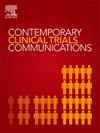Comparative main effects, mediators, and moderators of cognitive behavioral therapy, acceptance and commitment therapy, and emotional awareness and expression therapy for chronic spinal pain: Randomized controlled trial rationale and protocol
IF 1.4
Q4 MEDICINE, RESEARCH & EXPERIMENTAL
引用次数: 0
Abstract
Background
Chronic spinal (back/neck) pain is common and costly. Psychosocial treatments are available but have modest effects. Knowledge of treatment mechanisms (mediators and moderators) can be used to enhance efficacy. Trials that directly compare different treatments are needed to determine which mechanisms are treatment-specific, which are shared across treatments, and which contribute the most to outcomes.
Methods
We will conduct a 4-arm randomized, controlled clinical trial to compare the main effects, mediators, and moderators of three pain therapies: Cognitive-Behavioral Therapy, Acceptance and Commitment Therapy, and Emotional Awareness and Expression Therapy in adults with chronic spinal pain. Following baseline assessment of outcomes variables (two primary outcomes: pain intensity and pain interference) and potential mediators and moderators, we will randomize participants (up to 460) to one of the treatments or usual care control. Treatments will be conducted individually each week for 8 weeks via telehealth. We will conduct weekly assessments of both potential mediators and outcomes, as well as post-treatment and 6-month follow-up assessments. We will test whether any of the therapies is superior to the others (Aim 1); identify mediators that are specific to treatments and those that are shared across treatments (Aim 2); and identify baseline moderators that are specific to treatments or shared across treatments, and moderated mediators of treatments (Aim 3).
Discussion
The findings from this project can be used to improve the effects of psychosocial chronic pain treatments by identifying the most powerful specific and shared mechanisms and revealing for whom the mediator-outcome pathways are strongest.
认知行为疗法、接受与承诺疗法和情绪意识与表达疗法治疗慢性脊柱疼痛的主效应、调节因子和调节因子比较:随机对照试验的基本原理和方案。
背景:慢性脊柱(背部/颈部)疼痛很常见,而且代价高昂。目前已有社会心理治疗方法,但效果一般。了解治疗机制(介导因素和调节因素)可提高疗效。我们需要进行直接比较不同治疗方法的试验,以确定哪些机制是治疗方法特有的,哪些机制是不同治疗方法共有的,哪些机制对疗效贡献最大:我们将进行一项四臂随机对照临床试验,比较三种疼痛疗法的主要效果、中介效应和调节效应:方法:我们将开展一项四臂随机对照临床试验,比较三种疼痛疗法的主要效果、中介因素和调节因素,这三种疗法分别是认知行为疗法、接受与承诺疗法以及情绪认知与表达疗法。在对结果变量(两个主要结果:疼痛强度和疼痛干扰)以及潜在的中介因素和调节因素进行基线评估后,我们将随机分配参与者(最多 460 人)接受其中一种疗法或常规护理对照。在为期 8 周的时间里,每周将通过远程医疗单独进行治疗。我们将每周对潜在中介因素和结果进行评估,并进行治疗后和 6 个月的跟踪评估。我们将检验是否有任何一种疗法优于其他疗法(目标1);确定治疗方法特有的中介因素和不同治疗方法共有的中介因素(目标2);确定治疗方法特有的或不同治疗方法共有的基线调节因素,以及治疗方法的调节中介因素(目标3):讨论:本项目的研究结果可用于提高心理社会慢性疼痛治疗的效果,方法是确定最强大的特定机制和共享机制,并揭示谁的中介-结果途径最强。
本文章由计算机程序翻译,如有差异,请以英文原文为准。
求助全文
约1分钟内获得全文
求助全文
来源期刊

Contemporary Clinical Trials Communications
Pharmacology, Toxicology and Pharmaceutics-Pharmacology
CiteScore
2.70
自引率
6.70%
发文量
146
审稿时长
20 weeks
期刊介绍:
Contemporary Clinical Trials Communications is an international peer reviewed open access journal that publishes articles pertaining to all aspects of clinical trials, including, but not limited to, design, conduct, analysis, regulation and ethics. Manuscripts submitted should appeal to a readership drawn from a wide range of disciplines including medicine, life science, pharmaceutical science, biostatistics, epidemiology, computer science, management science, behavioral science, and bioethics. Contemporary Clinical Trials Communications is unique in that it is outside the confines of disease specifications, and it strives to increase the transparency of medical research and reduce publication bias by publishing scientifically valid original research findings irrespective of their perceived importance, significance or impact. Both randomized and non-randomized trials are within the scope of the Journal. Some common topics include trial design rationale and methods, operational methodologies and challenges, and positive and negative trial results. In addition to original research, the Journal also welcomes other types of communications including, but are not limited to, methodology reviews, perspectives and discussions. Through timely dissemination of advances in clinical trials, the goal of Contemporary Clinical Trials Communications is to serve as a platform to enhance the communication and collaboration within the global clinical trials community that ultimately advances this field of research for the benefit of patients.
 求助内容:
求助内容: 应助结果提醒方式:
应助结果提醒方式:


